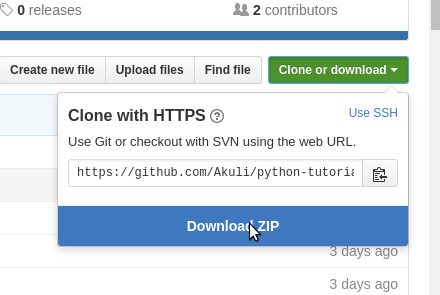Python programming tutorial for beginners
This is a concise Python 3 programming tutorial for people who think that reading is boring. I try to show everything with simple code examples; there are no long and complicated explanations with fancy words. If you have never programmed before click here to find out what programming is like and get started.
This tutorial is aimed at people with no programming experience at all or very little programming experience. If you have programmed a lot in the past using some other language you may want to read the official tutorial instead.
You can use Python 3.5 or any newer Python with this tutorial. Don't use Python 2 because it's no longer supported.
List of contents
The tutorial consists of two sections:
Basics
This section will get you started with using Python and you'll be able to learn more about whatever you want after studying it.
- What is programming?
- Installing Python
- Getting started with Python
- ThinkPython: The way of the program
- Variables, Booleans and None
- Using functions
- Setting up an editor
- If, else and elif
- Handy stuff with strings
- Lists and tuples
- Loops
- Trey Hunner: zip and enumerate
- Dictionaries
- Defining functions
- Writing a larger program
- What is true?
- Files
- Modules
- Exceptions
- Classes
- Docstrings
Advanced
If you want to learn more advanced techniques, you can also read this section. Most of the techniques explained here are great when you're working on a large project, and your code would be really repetitive without these things.
You can experiment with these things freely, but please don't use these techniques just because you know how to use them. Prefer the simple techniques from the Basics part instead when possible. Simple is better than complex.
Other things this tutorial comes with
- Important: getting help
- Contact me
- Answers for excercises in basics and advanced sections
- The TODO list
Frequently asked questions
How can I thank you for writing and sharing this tutorial?
You can star this tutorial. Starring is free for you, but it tells me and other people that you like this tutorial.
Go here if you aren't here already and click the "Star" button in the top right corner. You will be asked to create a GitHub account if you don't already have one.
How can I read this tutorial without an Internet connection?
-
Go here if you aren't here already.
-
Click the big green "Clone or download" button in the top right of the page, then click "Download ZIP".
-
Extract the ZIP and open it. Unfortunately I don't have any more specific instructions because how exactly this is done depends on which operating system you run.
-
Run
make-html.pyand follow the instructions.
If you have git and you know how to use it, you can also clone the
repository instead of downloading a zip and extracting it. An advantage
with doing it this way is that you don't need to download the whole
tutorial again to get the latest version of it, all you need to do is to
pull with git and run make-html.py again.
Authors
I'm Akuli and I have written most of this tutorial, but other people have helped me with it. See github's contributors page for details.
If you have trouble with this tutorial please tell me about it and I'll make this tutorial better. If you like this tutorial, please give it a star.
You may use this tutorial freely at your own risk. See LICENSE.
